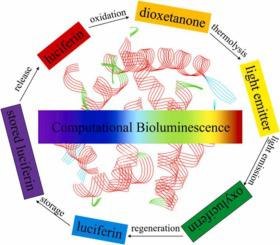Journal of Photochemistry and Photobiology C: Photochemistry Reviews ( IF 13.6 ) Pub Date : 2022-05-26 , DOI: 10.1016/j.jphotochemrev.2022.100537 Ya-Jun Liu

|
Bioluminescence (BL) is an amazing natural phenomenon whose visible light is produced by living organisms. BL phenomenon is quite pervasive and has been observed in 17 phyla of 4 kingdoms. This fascinating natural phenomenon has unceasingly attracted people’s curiosity from ancient era to today. For a very long time, we can only receive some sporadic and static information from experimental observations, the mechanism of most BL remains is unclear. How the chemical reaction of BL process is initiated? Where the energy for light emission comes from? How does the light emitter produce? What is the light emitter for a wild bioluminescent organism? How to regain luciferin for next bioluminescence when it is used up? The luciferin is utilized forthwith or stored and release for subsequent light emission? What factors affect the color and strength of a bioluminescence? How to artificially tune the bioluminescence for special application? Computational BL plays unreplaceable role in answering these mechanistic questions. In contrast with experimental BL, computational BL came very late. In the past two decades, computational BL has touched nearly all the bioluminescent systems with chemical bases via the method of multiscale simulation. In this review, the author firstly introduced the history, types and general chemical process of BL. Then, the computational scheme on BL was briefly epitomized. Using firefly BL as a paradigmatic case, the author summarized theoretical investigation on the six stages of general chemical process in a BL cycle: luciferin oxidation, peroxide thermolysis, light emission, luciferin regeneration, luciferin storage and luciferin release. At each stage, the available theoretical studies of other bioluminescent organisms are briefly introduced and compared with the firefly system. Basing on the mechanistic understanding, the author reviewed the up-to-date theoretical design on bioluminescent systems. Again, the firefly was mainly focused on, and the other possible systems were just briefly introduced. This review summarized the theoretical studies to date on BL and addressed the status, critical challenges and future prospects of computational BL.
中文翻译:

从多尺度计算的角度理解完整的生物发光循环:综述
生物发光(BL)是一种惊人的自然现象,其可见光是由生物体产生的。BL现象相当普遍,已在4个界的17个门中观察到。这种引人入胜的自然现象从古到今,不断吸引着人们的好奇。长期以来,我们只能从实验观察中获得一些零星的、静态的信息,大部分BL残骸的机制尚不清楚。BL工艺的化学反应是如何引发的?发光的能量来自哪里?光发射器是如何产生的?野生生物发光生物的发光体是什么?用完后如何重新获得荧光素以进行下一次生物发光?荧光素是立即使用还是储存和释放以供后续发光?哪些因素会影响生物发光的颜色和强度?如何为特殊应用人工调整生物发光?计算 BL 在回答这些机械问题方面发挥着不可替代的作用。与实验 BL 相比,计算 BL 来得很晚。在过去的二十年里,计算BL通过多尺度模拟的方法,几乎触及了所有具有化学基础的生物发光系统。在这篇评论中,作者首先介绍了历史,BL的类型和一般化学过程。然后,简要概括了 BL 上的计算方案。以萤火虫 BL 为例,作者总结了 BL 循环中一般化学过程的六个阶段的理论研究:萤光素氧化、过氧化物热解、发光、萤光素再生、萤光素储存和萤光素释放。在每个阶段,简要介绍了其他生物发光生物的现有理论研究,并与萤火虫系统进行了比较。在对机理认识的基础上,作者回顾了生物发光系统的最新理论设计。再次,主要关注萤火虫,其他可能的系统只是简单介绍。这篇综述总结了迄今为止关于 BL 的理论研究并解决了现状,



























 京公网安备 11010802027423号
京公网安备 11010802027423号